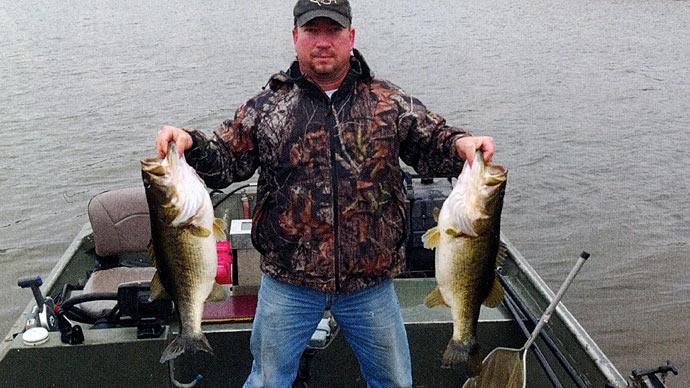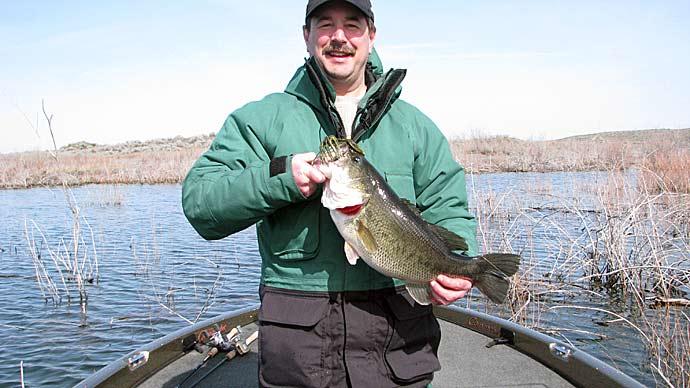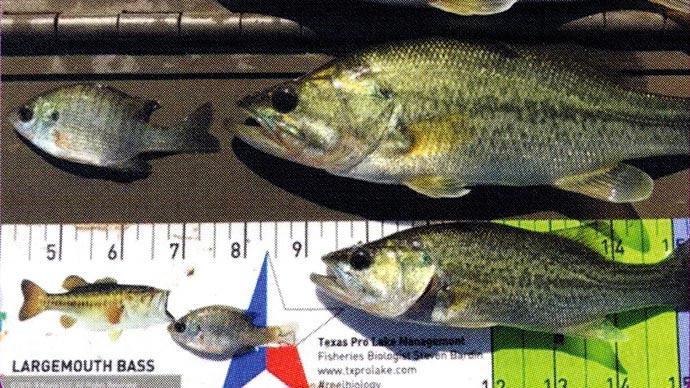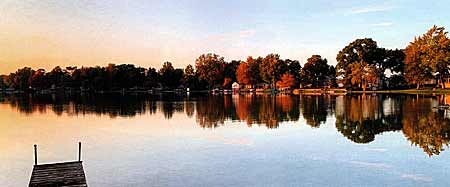
Fall. Glistening pond, warm sun, gentle breeze, huge fish at the business end of your rod and reel. Puffed out cheeks as you do battle. In the distance, friends and family are watching, cheering and laughing as they relax on the shore, wishing they were you. You've envisioned this moment over and over in your mind's eye. Your hard work and vision have led you to this place where the hands of time seem to move a little slower and life feels a little bit better.
Creating a private paradise for memorable moments like this requires substantial, ongoing vigilant work with enough foresight to match your vision. Creating this vision and understanding where to start can be just as challenging as staying ahead of inevitable unforeseen continuous ecosystem changes. This holds especially true when building a trophy fishery that complements the non-fishing social aspects of your vision. Time for a beer.
Whether you are still building the vision and have yet to break ground, or you are already ten years into quality times with loved ones, it is important to understand that your paradise is not necessarily everlasting. The fragility of any ecosystem can be viewed from the perspective that life is short Time is not on our side as we all age. So do ponds and their fishery. To complicate matters, some ability to continue financial support for a vision seems to naturally wane as we live life.
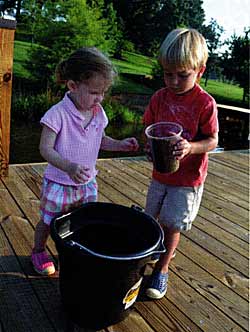
Of the risks that threaten your paradise, financial burdens or lifestyle changes are likely the main reasons a vision loses momentum. In this day and age, it is unnecessary for issues such as deteriorating water quality or a failed trophy fishery to hinder your success if you have both the desire and the financial capability to overcome Mother Nature's challenges. Today, we can pay to delay eutrophication.
Have another beer.
Unfortunately, some visions are shortlived or fail to meet full potential due to poor strategy and a lack of understanding about what is possible. After all, we don't know what we don't know. One key problem we've seen is absence of experience and foresight which leads to complacency. One day, you may realize that you are off-track; as the slow erosion of success has pushed the project far away from the original vision.
Staying on track is an intentional process. The creation of paradise is hard work. Once you reach your goals, the work does not stop. Although it often takes less work to sustain what's created, people will find success is short-lived with complacency.
When seeking long-term success, start with a waterbody properly sized for its watershed. If unable to do so, work with a professional who can evaluate and develop a solution.
Next, test water quality parameters such as dissolved oxygen (DO), pH, alkalinity, hardness, nitrate, nitrite, total nitrogen, free phosphorus and total phosphorus. Based on goals, lake management professionals can help interpret and amend acceptable water quality ranges. As water quality starts drifting out of the desired range, a correction should be made.
Background water quality drives variables such as how clear or how productive water will become. If clean, clear water is desired, water quality will need to be manipulated accordingly. If a goal is to grow fish, productive water that allows for a robust food chain is typically required.
Sometimes, paradise has clean, biologically unproductive water with beautiful flowering plants along the shoreline, while other times a more productive waterbody is 25 percent covered in vegetation with an ecosystem teeming with wildlife. Build the vision for what you are trying to accomplish. Then, incorporate a data-driven, adaptive management strategy that captures the necessary data and makes necessary management adjustments—and continually repeat this strategy over time.
Although it may sound simple, most people overlook how their waterbody is aging relative to their goals. If you aim to
create an avid waterfowl hunting destination with wall to wall vegetation, this aging process is likely good for you; but if your vision includes clean water or a productive fishery free of toxin-producing blue-green algae, then it is important that to take necessary steps to keep water quality within acceptable ranges relative to goals.
Ready for one more beer?
Creating a trophy Largemouth Bass fishery ranks high on the list of many visions for private lakes and ponds. Unfortunately, creating and sustaining an effective fishery adds a layer of complication to an already vulnerable vision. Fisheries fail for many reasons, so it is important that management strategy is sound and you resist temptations to become complacent as you achieve initial goals.
Largemouth Bass have relatively short lives. As a result, it is critical that fisheries have multiple generations of bass at all times. You need a freshman team, a junior varsity, and champions coming up the pipe. Don't let tunnel vision drive short-term success by focusing only on the first generation of fish. If that happens, the fishery will decline and a pond owner won't know it until year ten or later.
Know how many generations make up your fish population. Plus, know if each age-class is growing to their potential. Don't wait a few years and try to figure it out. Gather data. Lengths and weights, ongoing data helps you help your fishery.
Sure, it takes time and some effort to weigh and measure enough fish to deduce a population status as is develops and thrives.
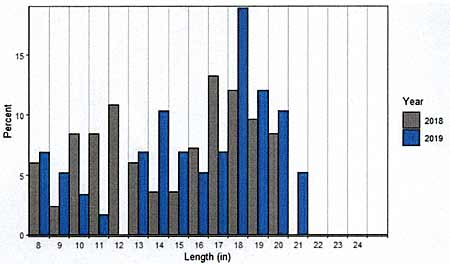
Data drives paradise. Remember that. Five years from now, you'll offer your biologist a beer.
Here's a real deal. A six-year-old trophy Largemouth bass fishery in the mid-Atlantic is a great example of a paradise currently vulnerable to losing significant momentum in the next 3-5 years. It serves as a classic example of how hard-working, intelligent people run the risk of becoming complacent as they achieve their goals. As seen in Figure 1, the relatively new fishery is doing well and has an outstanding population of 17-21-inch bass. These bass are six-years old and range between four and seven pounds.
It is normal for pond owners to be complacent in this moment since the fishing is great and each year gets better and better. This optimism, teamed with inexperience, can result in failing to recognize that greater than 50% of their bass population is six years old. They are at risk of having a far poorer quality fishery once that age-class of large fish dies-off in a few years.
The good news is management strategies are available to keep this fishery on track for sustainable success. To do this, their biologist needs accurate data as well as the proper foresight and experience to make the correct management decisions. Then, he needs to convey it to the landowner to stay on point.
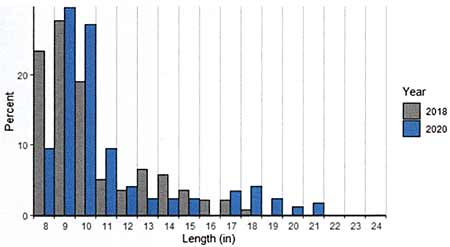
Here's another. A recently-built large pond located in the Midwest has also found itself in a common predicament amongst people looking to grow big fish. Although it is hard to see in Figure 2, the fishery has a robust population of 17-21-inch bass. These fish are six years old and range between four and seven pounds.
As more clearly visible comparing with Figure 2, this lake is plagued with a high level of Largemouth bass recruitment continually threatening growth rates of all predator fish due to the high pressure put on small forage fish. As a result, management efforts had prioritized the harvest of thousands of small bass and black crappie annually to allow the oldest generation of adult bass to one-day reach 7-10 pounds. This lake has a propensity to grow lots of small bass. If this is known, management strategies can counterattack.
The harvesting effort here has shown success and the oldest generation of bass have continued growing well. But, the ripple effect of this management strategy has left a noticeable gap in the age classes of fish, and the lake is lacking 3-4-year-old bass that range between 2-3 pounds. If this data is available, these fish can be replaced. It costs some dollars, but can be done.

The owner's decision to only electrofish every two years has resulted in collecting insufficient data over the long term needed to make the proper management decisions. As a result, this pondmeister is in a precarious situation where he needs to either stock a generation of 3-4-year-old fish that average 2-3 pounds, or accept that in 3-5 years the number of large bass caught will decline noticeably and their fishing paradise will become far less enjoyable. Budget $30 per pound to replace those fish. Think five or six pounds per acre.
Overcoming these challenges isn't necessarily difficult. Collecting the right data at the proper frequency, and teaming that data with accurate foresight is the hard part. Once again, we don't know what we don't know. Experience helps. It's hard to buy experience.
If you are building paradise or simply looking to keep paradise on track, make sure to have the right team of people leading a data driven, adaptive management approach. With good planning and hard work, your vision will come to life in a sustainable way and family and friends will spend many years building lasting memories, rather than reminiscing on the "good times."
David Beasley is a Fisheries Biologist and the Director of Fisheries at SOLitude Lake Management, an environmental firm providing sustainable lake, stormwater pond, wetland and fisheries management solutions. Learn more about this topic at www.solitudelake-management.com/knowledge
Reprinted with permission from Pond Boss Magazine

